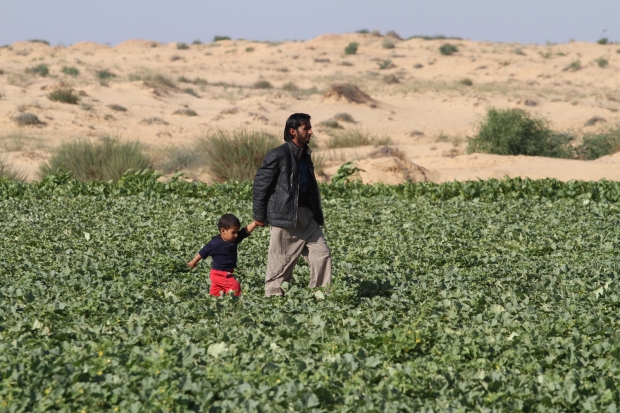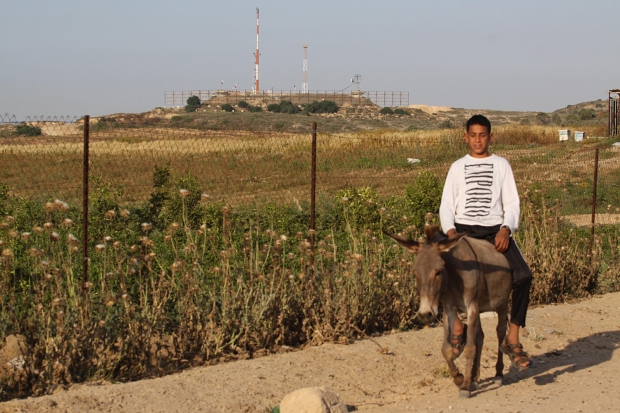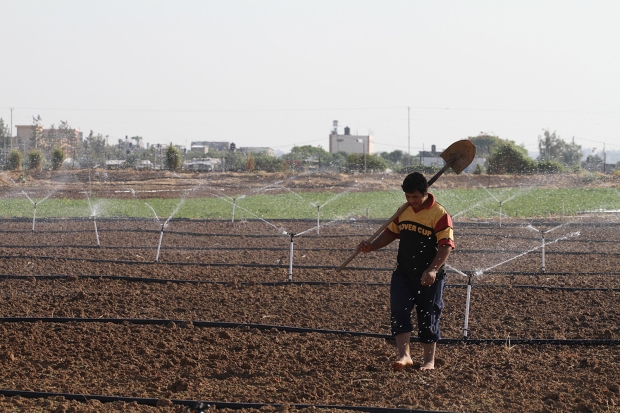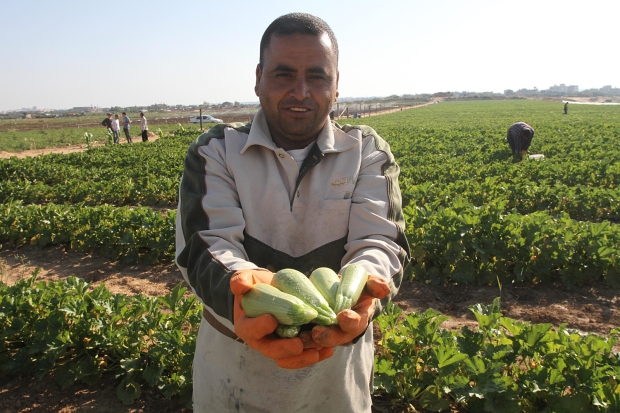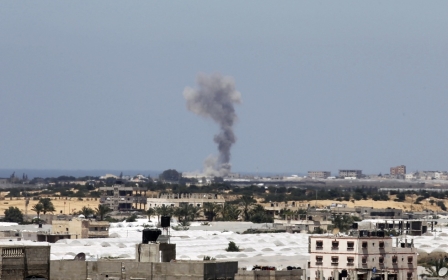On Gaza's embattled margins, farmers wage a quiet struggle to reclaim the land
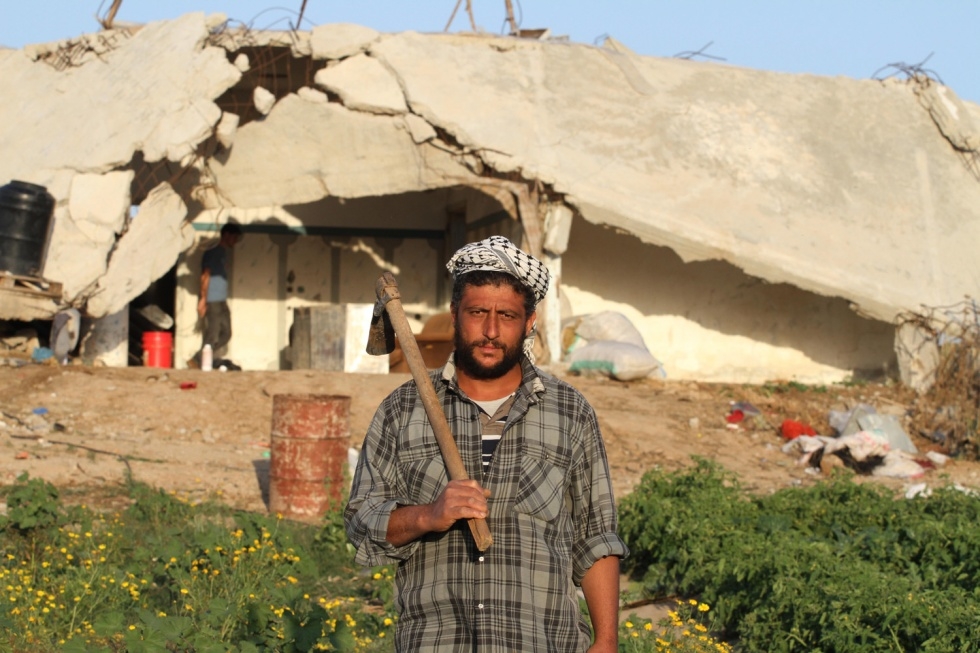
Nestled into the northeastern corner of the Gaza Strip, where the separation barrier Israel built around the Palestinian enclave in 1994 curves from the east to the south, Wael Wahdaan's three fields illustrate the options facing many local farmers.
The land, in the Palestinian city of Beit Hanoun, lies within sight of the white houses and red roofs of Sederot, a settlement on the Israeli side of the barrier. Between them stand Israeli observation towers and the fence itself, behind which military vehicles and tanks periodically pass.
Wahdaan's family owns two patches of this contentious land: 36 dunums (3.6 hectares) 400 meters away from the barrier, and another four (0.4 hectares), a kilometer to the south, that actually reach it. Wahdaan rents another 100 dunums (10 hectares) that lie 300 meters from the fence.
On the Wahdaans' 36 dunums, they grow cantaloupes, eggplants, lemons, onions, peppers and watermelons. But Wahdaan's rented 100 dunums contain a single crop: wheat. It offers lower profits than the others, he said, but also fewer risks and reduces the dangers of farming in the "buffer zone."
"I work every day on my own 36 dunums," Wahdaan said. "On the 100 planted with wheat, I go on only two days, when I plant and when I harvest. And wheat is cheap."
New MEE newsletter: Jerusalem Dispatch
Sign up to get the latest insights and analysis on Israel-Palestine, alongside Turkey Unpacked and other MEE newsletters
Wahdaan’s work so close to the barrier is part of a wider push by Palestinian farmers testing the limits of a 2012 ceasefire between Israel and Palestinian groups.
Palestinian farmers working by the barrier, an area alternately called the access-restricted area or the "buffer zone," face the prospect of not only live gunfire from the Israeli forces patrolling it, but also incursions by Israeli bulldozers that level fields, sometimes destroying both months of work and substantial investments.
In its "2013 Statistical Report on Israeli Attacks in the Access Restricted Areas," Gaza's Al Mezan Center for Human Rights reported 57 shooting incidents that year. These resulted in the death of a farmer and eight further injuries, including one child. Over the same period, the center documented 55 incursions to level farmland, in which one additional person was killed and four injured.
But in a slither of land that is home to more than 1.8 million people but just some 25 kilometers long and as little as 4 kilometers wide, every patch of earth counts.
"This area is the food basket of the Gaza Strip,” said Akram Abu Daggah, the director of evaluation and monitoring at Gaza’s Ministry of Agriculture.
“It has the most fertile land. It was left idle for ten years, so the soil now has a high quality for cultivation. And it is accessible again."
To try to revive this highly-prized land, the ministry says it has plans to develop a network of new agricultural infrastructure such as electrical lines, pipelines, reservoirs, roads as well as water treatment facilities. The hope is that this investment will encourage farmers to return and to redevelop the land.
The 2012 truce
Israel officially withdrew its troops from Gaza in 2005, although tensions escalated dramatically in 2006 after Hamas won elections and quickly consolidated their power over the Strip. Fighting has flared up periodically ever since.
In 2012 the violence escalated yet again, culminating in an eight-day Israeli air offensive on the Strip that was greeted with waves of retaliatory rocket fire from Gaza.
On 21 November, in a deal brokered by Egypt, Israel agreed to "stop all hostilities in the Gaza Strip land, sea and air including incursions and targeting of individuals," as well as to refrain "from restricting residents' free movements and targeting residents in border areas."
But despite the truce, both gunfire and incursions by the barrier have continued, although farmers say the deal has eased tensions sufficiently to allow them to access previously out-of-bounds land.
"From 2006 until 2012, we didn't plant it," Wahdaan said of his 100 rented dunums. "We started in 2012, after the truce."
Prior to the ceasefire, a history of Israeli leveling, and the likelihood of its recurrence, had dissuaded him from venturing further.
"In 2003, they bulldozed my home," he said, gesturing toward its wreckage nearby. "It has been the same since then. They bulldozed the whole 136 dunums in 2003, 2004, 2006, 2007 and 2008."
The morphing buffer zone
But the new contours of the "buffer zone" have proven hard to define. Prior to the 2012 Israeli offensive, they were officially set at 300 meters, although they often reached much further into Palestinian territory.
An Israeli army spokesperson stirred controversy last month by insisting that a new 100m limit was now known and widespread, but Gazan authorities and human rights groups were quick to refute this claim, pointing out that previous spokespeople have kept to the 300m line.
Nabil Abu Shamla, director of policy and planning at the Ministry of Agriculture, told Middle East Eye that his office's attempts to map the area were ongoing but incomplete.
"We've spent six months collecting social data from agricultural families near the 'buffer zone,'" he said. "We're still working on data entry."
But he added that since the 2012 ceasefire, the land available to Gaza farmers had greatly increased.
"The access-restricted area, before the ceasefire, ran up to 600 or 1,000 meters," he said. "Now, in some places, it's only 100 meters. You can see a lot of lands that are newly cultivated."
Until Abu Shamla finishes his research, the amount of newly available land will be hard to quantify. Some areas, like Wahdaan's corner of Beit Hanoun, remain dangerous anywhere within 300 meters from the barrier. In others, the limit has moved much closer.
"It's arbitrary," said Mohammed al-Bakri, Gaza director for the Union of Agricultural Work Committees.
Gesturing at a map on the wall of his office, Bakri indicated a farm in the northwestern corner of the Gaza Strip, a few kilometers from Wahdaan's, where he had seen farmers approach 100 meters from the barrier.
"In 2006, the agricultural land was 120,000 dunums [12,000 hectares]" he said.
"In 2011, it was 73,000 dunums [7,300 hectares]. We lost a lot of land. This is dangerous, and especially endangers food security. It will increase reliance on imports, while weakening our own production."
Seeds of change begin to bear fruit
Like the ministry of agriculture, Bakri’s organization is planning a range of development projects, funded by international donors, to encourage farming in the "buffer zone."
The NGO also engages in public campaigns to discourage Israeli military activities against farmers in the areas.
"We want to support these farmers in two ways: through access, and politically," Bakri said. "Access alone is not enough. We have to campaign, locally and internationally, to defend the rights of farmers to use their lands."
"We want to focus on the international community, to say, 'it's enough,'" he added.
His organization's activities range from a series of rallies to support the boycott of Israeli agricultural products to the distribution of seeds and water carriers, he said.
Its efforts to encourage the development of the "buffer zone," he added, require a delicate balance between acquiescing to Israeli military restrictions and challenging them excessively, triggering incursions and leveling.
"I don't want to give the Israeli side an excuse to destroy this land under a pretext of security," he said.
"We are still speaking about vegetables," the agriculture ministry’s Abu Shamla said, in reference to planting the ministry encourages by the barrier.
The Israelis have forbidden planting trees out of alleged security concerns that they reduce visibility and could make it easier to launch attacks on their border patrollers.
"The buffer zone was reduced," he said. "We can't say it was eliminated. The risk in this area is still high."
Reform limits
Even if the gunfire and bulldozers retreat, however, Gaza’s farmers will continue to face grave challenges.
"The main Israeli restriction now is the import-export process,” said Abu Shamla. “They control the borders. We have an annual surplus, estimated at $40-50m, we can't export. And we can't import materials vital for agricultural development."
Last year, according to the Gaza Crossings Activities Database maintained by the United Nations Office for the Coordination of Humanitarian Affairs, 26,092 truckloads of agricultural products entered the Gaza Strip from Israel. Simultaneously, the Israeli army allowed only 178 truckloads of Palestinian agricultural exports to go out.
Current levelling operations compound the damage of previous military offensives. According to media reports, severe damage was inflicted on a third of Gaza's farmable land during Operation Cast Lead.
And years of levelling have taken their toll. According to a February report by Gaza's Palestinian Centre for Human Rights and Geneva's Internal Displacement Monitoring Centre, "the restrictions on land cover 62.6 square kilometres, accounting for 35 per cent of agricultural land and 17 per cent of all land in the territory.
“Of the total, 24.4 square kilometres have been levelled and would require significant investment to develop or farm. The restrictions have led to the annual loss of an estimated 75,000 tonnes of agricultural output, worth around $50 million."
In January, after an increase in the Israeli army's use of live gunfire against civilians in the "buffer zone," the United Nations' Office for the Coordination of Humanitarian Affairs said, "The Israeli army's practice of using live fire against civilians, as well as destruction, damage and confiscation of property to enforce access restrictions, remains of concern."
Last month Sarah Leah Whitson, Middle East director at Human Rights Watch, said, "Month after month, Israeli forces have wounded and killed unarmed Palestinians who did nothing but cross an invisible, shifting line that Israel has drawn inside Gaza's perimeter."
"It's appalling that soldiers have shot men, women, and children apparently for simply crossing a line," she added.
"The statement ridicules human rights," Lieutenant Colonel Lerner told the AFP in response. "This week alone we've had numerous attacks emerging from the immediate perimeter of the fence."
In Beit Hanoun, Wahdaan said, shooting is more likely to follow an escalation of political tensions between Israel and Palestinians, regardless of the security condition.
"Our security here depends on the political situation," he said. "I'm worried now, because the situation is tense, and planting is costly."
"They shoot randomly," he added. "They shot today, yesterday, and the day before."
Still, he said, conditions for nearby farmers have improved.
"Since the last war, nobody here has been shot," he said. "They still shoot at us, but haven't injured anyone yet."
Middle East Eye delivers independent and unrivalled coverage and analysis of the Middle East, North Africa and beyond. To learn more about republishing this content and the associated fees, please fill out this form. More about MEE can be found here.



